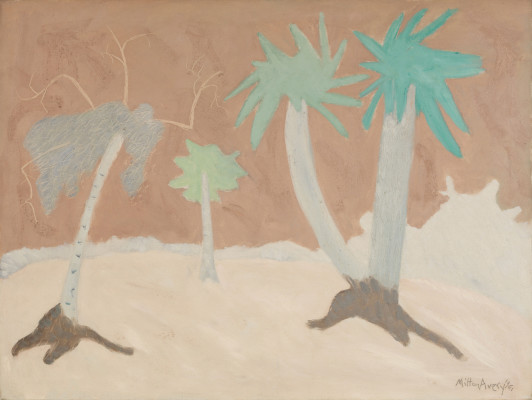
Milton Avery
Palms, 1951
Oil on canvas
76.2 x 101.6 cm
30 x 40 in
30 x 40 in
A prime example of Avery's ability to learn from himself is the period during 1949 and 1950 when, recuperating from a heart attack, he temporarily renounced painting and devoted himself to making monotype prints. A technique that required simplicity and speed, the monotype forced Avery to become more abstract, fresher and more immediate, when he returned to painting after making more than 200 monotypes, it was with a new clarity and a greater boldness in simplification. Bonnie Lee Grad (1990) p. 15
After his first major heart attack in 1949, Milton Avery was invited to winter in Maitland, Florida, as a Bok Fellow at the Research Studio for painters and writers, now known as the Maitland Art Center. Sally, Milton and March Avery wintered there in 1949-50 as did their artist-friends Arnold Blanch and Doris Lee, Boris Margo and Jan Gelb. The Maitland Art Colony had been founded in 1937 by J. André Smith under the patronage of Philadelphia philanthropist Mary Louise Curtis Bok, for the advancement of experimental art. During the winter of 1950-51, the Averys returned in the company of their friends, the painter Wallace Putnam and his wife, photographer Consuelo Kanaga.
Because of his weakened physical state, Avery began experimenting in Maitland with creating smaller-scale work in monotype. He made over two hundred works in that medium, most during that two-year period. “To Avery it was a most auspicious medium for its softness of tone and the disciplined order of its color sequences. The resulting forms offered still another means of capturing the very essence of an image.” Una Johnson (1966) p. 11
Avery's stay Maitland also inspired a series of oil paintings with Florida motifs - Brahmin cows and bulls, race horses, Florida lakes and rivers, fish, seabirds, and . . . palm trees. In some rare cases, such as Palms and Evening Palms, and Bird & Sea he approached the same composition in both mediums. It is interesting that the Palms is a mirror image of the monotype. Although some of Avery's Florida canvases have hotter palettes, Palms, is distinctly Floridian in its range of subtly sun-washed greens, grays, and earth colors, which also dominate in Bird and Sea, Brahmin and Palms, Brahmin Bulls, Florida Swamp, Trotters, Moon Over Miami, Twisting River, and other paintings.
Exhibitions
Milton Avery: The Shape of Color, (organized by Waqas Wajahat LLC). Schwartz-Wajahat, New York, NY, 2016.
Publications
Wajahat, Waqas. Milton Avery: The Shape of Color, Schwartz-Wajahat, New York, NY (2016). Illustrated.